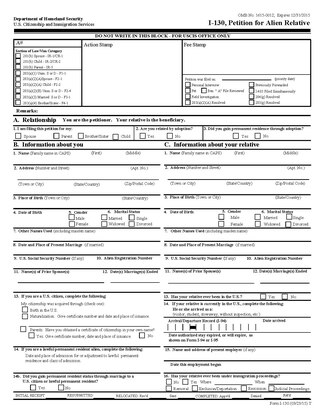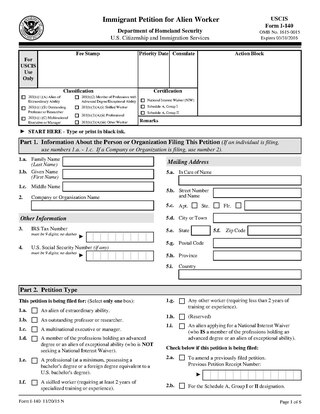Related Research Articles

A green card, known officially as a permanent resident card, is an identity document which shows that a person has permanent residency in the United States. Green card holders are formally known as lawful permanent residents (LPRs). As of 2023, there are an estimated 12.7 million green card holders, of whom 9 million are eligible to become United States citizens. Approximately 18,700 of them serve in the U.S. Armed Forces.
A K-1 visa is a visa issued to the fiancé or fiancée of a United States citizen to enter the United States. A K-1 visa requires a foreigner to marry his or her U.S. citizen petitioner within 90 days of entry, or depart the United States. Once the couple marries, the foreign citizen can adjust status to become a lawful permanent resident of the United States. Although a K-1 visa is legally classified as a non-immigrant visa, it usually leads to important immigration benefits and is therefore often processed by the Immigrant Visa section of United States embassies and consulates worldwide.
TN status is a special non-immigrant classification of foreign nationals in the United States, which offers expedited work authorization to a citizen of Canada or a national of Mexico. It was created as a result of provisions of the North American Free Trade Agreement that mandated simplified entry and employment permission for certain professionals from each of the three NAFTA member states in the other member states. The provisions of NAFTA relevant to TN status were then carried over almost verbatim to the United States–Mexico–Canada Agreement that replaced NAFTA in 2020.
U.S. Citizenship and Immigration Services (USCIS) is an agency of the United States Department of Homeland Security (DHS) that administers the country's naturalization and immigration system. It is a successor to the Immigration and Naturalization Service (INS), which was dissolved by the Homeland Security Act of 2002 and replaced by three components within the DHS: USCIS, Immigration and Customs Enforcement (ICE), and Customs and Border Protection (CBP).
The V visa was a temporary visa available to spouses and minor children of US lawful permanent residents. It allowed permanent residents to achieve family unity with their spouses and children while the immigration process took its course. It was created by the Legal Immigration Family Equity Act of 2000. The Act is to relieve those who applied for immigrant visas on or before December 21, 2000. Practically, the V visa is currently not available to spouses and minor children of LPRs who have applied after December 21, 2000.

Visitors to the United States must obtain a visa from one of the U.S. diplomatic missions unless they are citizens of one of the visa-exempt or Visa Waiver Program countries.
Adjustment of status in the Immigration and Nationality Act (INA) of the United States refers to the legal process of conferring permanent residency upon any alien who is a refugee, asylee, nonpermanent resident, conditional entrant, parolee, and others physically present in the United States.

Adams v. Howerton, 673 F.2d 1036, cert. denied, 458 U.S. 1111 (1982) is a decision from the United States Court of Appeals for the Ninth Circuit that held that the term "spouse" refers to an opposite-sex partner for the purposes of immigration law and that this definition met the standard at the time for rational basis review. It was the first U.S. lawsuit to seek recognition of a same-sex marriage by the federal government.
Richard Frank Adams was a Filipino-American gay rights activist. After his 1975 same-sex marriage was declared invalid for the purposes of granting his husband permanent residency, Adams filed the federal lawsuit Adams v. Howerton. This was the first lawsuit in America to seek recognition of a same-sex marriage by the federal government.
The United States policy regarding same-sex immigration denied couples in same-sex relationships the same rights and privileges afforded different-sex couples based on several court decisions and the Defense of Marriage Act (DOMA) until the U.S. Supreme Court ruled Section 3 of DOMA unconstitutional in United States v. Windsor on June 26, 2013.
The U visa is a United States nonimmigrant visa which is set aside for victims of crimes who have suffered substantial mental or physical abuse while in the U.S. and who are willing to assist law enforcement and government officials in the investigation or prosecution of the criminal activity. It permits such victims to enter or remain in the US when they might not otherwise be able to do so. An advantage that comes along with the acceptance of a U-visa is the individual will have deportation protection which is important when they are collaborating with law enforcement.
The American Competitiveness in the 21st Century Act (AC21) was an act passed by the government of the United States in October 2000, pertaining to immigration to the United States. It was a complement to the American Competitiveness and Workforce Improvement Act that had been passed in 1998. The focus of AC21 was to change rules related to portability and caps for the H-1B visa to increase the effective number of visas available and make it easier for workers on those visas to switch jobs. Although the language of the Act references the Immigration and Naturalization Service (INS), the INS would soon be restructured and the functions of the INS referenced in AC21 would be handled by United States Citizenship and Immigration Services.
Premium Processing Service is an optional premium service offered by the United States Citizenship and Immigration Services to individuals and/or employers filing Form I-129, Form I-140, Form I-539 or Form I-765 petitions. To avail of the service, the applicant needs to file Form I-907 and include a fee that is $1,500 for the H-2B and R classifications and $2,500 for all others.
The United States Citizenship and Immigration Services (USCIS) issues a number of forms for people to submit to them relating to immigrant and non-immigrant visa statuses. These forms begin with the letter "I". None of the forms directly grants a United States visa, but approval of these forms may provide authorization for staying or extending one's stay in the United States as well as authorization for work. Some United States visas require an associated approved USCIS immigration form to be submitted as part of the application.

Form I-130, Petition for Alien Relative is a form submitted to the United States Citizenship and Immigration Services by a United States citizen or Lawful Permanent Resident petitioning for an immediate or close relative intending to immigrate to the United States. It is one of numerous USCIS immigration forms. As with all USCIS petitions, the person who submits the petition is called the petitioner and the relative on whose behalf the petition is made is called the beneficiary. The USCIS officer who evaluates the petition is called the adjudicator.
The National Visa Center (NVC) is a center that is part of the U.S. Department of State that plays the role of holding United States immigrant visa petitions approved by the United States Citizenship and Immigration Services until an immigrant visa number becomes available for the petition, at which point it arranges for the visa applicant(s) to take the visa interview at a consulate abroad. It is located in Portsmouth, New Hampshire. It was established on July 26, 1994, on the site of an Air Force base that was closed down by The Pentagon.
The Legal Immigration Family Equity Act of 2000, also known as the LIFE Act and as the Legal Immigration and Family Equity Act, along with its Amendments, made some changes to laws surrounding immigration for family members of United States citizens and Lawful Permanent Residents, as well as people eligible for employment-based immigrant visas, in the direction of making it easier for family members and immigrant workers to move to and adjust status within the United States. It was passed on December 21, 2000, as title XI of Pub. L. 106–553 (text)(PDF).
Special Immigrant Juvenile Status (SIJS) is a special way for minors currently in the United States to adjust status to that of Lawful Permanent Resident despite unauthorized entry or unlawful presence in the United States, that might usually make them inadmissible to the United States and create bars to Adjustment of Status. The key criterion for SIJS is abuse, neglect, or abandonment by one or both parents.

Form I-140, Immigrant Petition for Alien Worker is a form submitted to the United States Citizenship and Immigration Service (USCIS) by a prospective employer to petition an alien to work in the US on a permanent basis. This is done in the case when the worker is deemed extraordinary in some sense or when qualified workers do not exist in the US. The employer who files is called the petitioner, and the alien employee is called the beneficiary; these two can coincide in the case of a self-petitioner. The form is 6 pages long with a separate 10-page instructions document as of 2016. It is one of the USCIS immigration forms.
A family visa is a type of immigration visa issued by the governments of various countries for family reunification purposes in a foreign country.
References
- ↑ "What to expect at the Stokes Interview". www.Statusimigration.com. www.Statusimigration.com. Retrieved 23 August 2016.
- 1 2 Apsan, Moses. "THE MARRIAGE FRAUD INVESTIGATION "The Stokes Interview"". Aspan Law Office. Moses Aspan. Retrieved 25 August 2016.
- 1 2 "What to Expect at a Stokes Interview". Find Law. Find Law. Retrieved 23 August 2016.
- ↑ "Stokes v. U.S. Immigration and Naturalization Service". www.clearinghouse.net. UNIVERSITY OF MICHIGAN LAW SCHOOL. Retrieved 23 August 2016.
- ↑ "Stokes vs INS Memorandum" (PDF). UNIVERSITY OF MICHIGAN LAW SCHOOL. UNIVERSITY OF MICHIGAN LAW SCHOOL. Retrieved 25 August 2016.
- ↑ "Our History". USCIS. USCIS. Retrieved 25 August 2016.
- ↑ "The Immigration Marriage Interview What To Expect During Your Immigration Marriage Interview". Scott Legal. legal services incorporated. Retrieved 23 August 2016.
- ↑ "I-130, Petition for Alien Relative". UCIS. USCIS. Retrieved 2 September 2016.